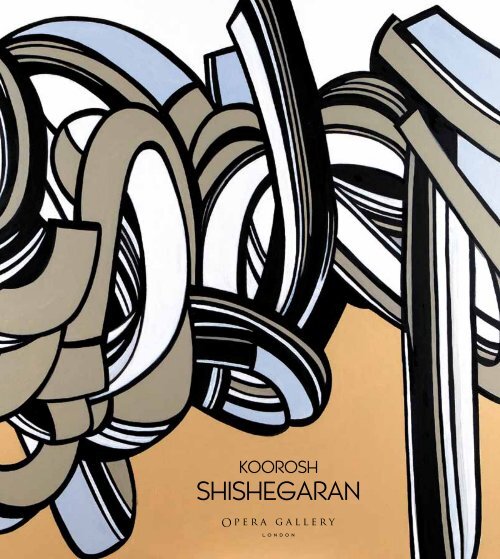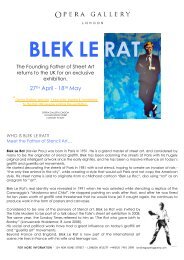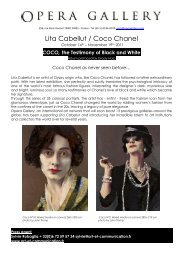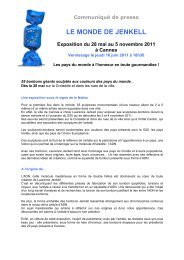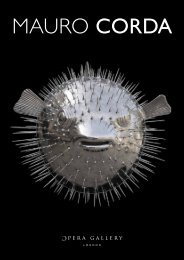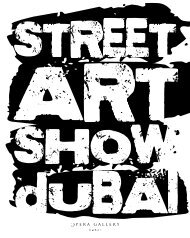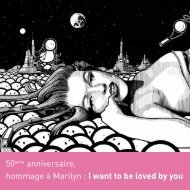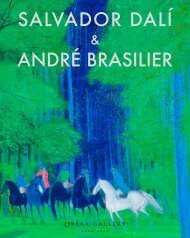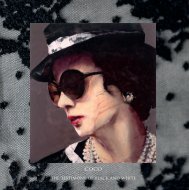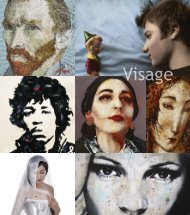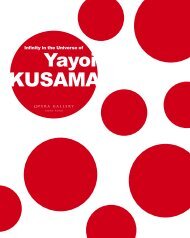Download - Opera Gallery
Download - Opera Gallery
Download - Opera Gallery
You also want an ePaper? Increase the reach of your titles
YUMPU automatically turns print PDFs into web optimized ePapers that Google loves.
KOOROSH<br />
SHISHEGARAN<br />
1
KOOROSH<br />
SHISHEGARAN<br />
<strong>Opera</strong> <strong>Gallery</strong> is pleased and very proud to present the works of Iranian abstract painter<br />
Koorosh Shishegaran in a solo exhibition in London for the first time.<br />
Shishegaran’s ability to humanize abstraction and bring three dimensions onto his canvases and<br />
through the brush strokes and colours, make him one of the most expressive and emotive artists<br />
of the contemporary Iranian art movement.<br />
It is an honour for us to show this selected assortment of his greatest and latest paintings in our<br />
London gallery and consequently present the deserving artist to the UK art lovers and collectors.<br />
Gilles Dyan<br />
Founder and Chairman<br />
<strong>Opera</strong> <strong>Gallery</strong> Group<br />
Jean-David Malat<br />
Director<br />
<strong>Opera</strong> <strong>Gallery</strong> London<br />
2 3
“We live in complex times: of breathlessness and excitement, of ties and confusions, of contradictions and mysteries,<br />
of disturbances and breakneck speed; of colour, exploding wonders and novelties; in short, a complicated world for<br />
today’s man. I have been trying to find a style or language expressive of the modern era. One that can be seen as<br />
pure painting yet rooted in my own country’s art and culture.”<br />
Shishegaran’s world is a vivid matrix of fluid dynamics and channelled complexity, where word, pattern, geometry<br />
and colour synthesise into a torrid visual language. Harnessing the myriad cultural legacies of his native Iran, he<br />
shoots fragments of the Orient through the contemporary prism of pop art and modernism with a freestyle nod to<br />
graffiti woven into the ride. Exploring the essence of line, pattern and subjective meaning within a set of personal<br />
“rules” about the courtship of calligraphy, his bold tapestries of form distil into profoundly human moments as hints<br />
of portraiture peek out from behind the oscillating folds.<br />
Characterized by freeform calligraphic stylization on solid fields of colour, bold lines twist, turn and whirl ecstatically<br />
through precision spirals of connected chaos. Electrifying the ancient, the slow, deliberate movements of traditional<br />
calligraphy mutate into a charged poetry of lyrical elegance that dances the visual rapture of conflicted emotions.<br />
Exuberant loops and bolts of iridescence spring over the muted backgrounds with an intoxicating energy and sweep<br />
the viewer deep into the swirls of pure movement.<br />
Traces of his past work and a fascination with the graphic arts reveal themselves in the sharp incisive lines, the industrial<br />
colours and the interplay with the paintings own negatives. At once playfully irreverent and spiritually searching,<br />
dramatic compositions rush and race across the canvas as a frenzied spontaneity teetering on the edge of rampaging<br />
abandon is fed back into a graceful order.<br />
“There are many untold mysteries within a portrait. Once told, they project a different world far more interesting<br />
than the one apparent to us. The artist who can detach himself from the appearance will find a unique way of<br />
projecting his apprehensions.”<br />
Echoing the philosophy of Persian calligraphy and painting where each portrait, line, gesture and nuance is a<br />
mystery unto itself, the elusive caricatures of the whimsical and often humorous subjects seduce the viewer into<br />
a visual game while giving the artist the liberty to delve beyond appearances and deep into the symbolic. Through<br />
abstract form, Shishegaran resists emotional and psychological clues to avoid influencing external experiences of<br />
the work, thus allowing the viewer to forge their own narrative within the entangled coils.<br />
In the primal dialectic of being and nothingness, solid and void, mind and body, the movement and momentum of his<br />
eternal spirals flow along the vortices of invisible objects as they whirl free in liquid space. Light and shadow pour<br />
through the slipstream ravelling and unravelling into snatched flashes of three-dimensional form. A perpetual tension,<br />
a taut dualism, an alchemical turn of reality’s wheel that crystallizes again and again into a mesmerizing, shape<br />
shifting whole.<br />
“ I am a painter and communicate with line, point, colour, and image.”<br />
Zahra Faridany Akhavan PhD<br />
Specialist in Iranian and Islamic Art<br />
4 5
Untitled, 2011<br />
Acrylic on canvas - 120 x 120 cm - 47.2 x 47.2 in.<br />
6 7
Untitled, 2011<br />
Acrylic on canvas - 130 x 130 cm - 51.2 x 51.2 in.<br />
Untitled, 2011<br />
Acrylic on canvas - 160 x 130 cm - 63 x 51.2 in.<br />
8 9
Figure, 2011<br />
Acrylic on canvas - 160 x 130 cm - 63 x 51.2 in.<br />
10 11
I always thought to myself why we should not paint a portrait in an abstract form. An abstract portrait gives<br />
the artist liberty to look beyond the appearance into subject in a symbolic way. There are many unspoken<br />
secrets within a portrait that once revealed, present a very different world. It is a world of appearance. Every<br />
artist has his unique way of depicting his subjects if he tries to detach himself from the appearance.<br />
My portraits, 2008<br />
Plot-Painting: inkjet print on canvas, unique piece - each piece is signed with acrylic colour - Triptych: 140 x 300 cm - 55.1 x 118.1 in.<br />
12 13
Untitled, 2011<br />
Acrylic on canvas - Diptych: 134 x 134 cm - 52.8 x 52.8 in.<br />
14 15
The bird, 1982<br />
Gouache on cardboard - 12 x 15 cm - 4.7 x 5.9 in.<br />
16 17
The bird, 2012<br />
Acrylic on canvas - 100 x 160 cm - 39.4 x 63 in.<br />
18 19
Green head, 2009<br />
Acrylic on canvas - 170 x 120 cm - 66.9 x 47.2 in.<br />
20 21
Untitled, 2000<br />
Acrylic on canvas - 130 x 130 cm - 51.2 x 51.2 in.<br />
22 23
Koorosh Shishegaran was born in Qazvin in 1944, but then moved to Tehran with his family. He finished elementary school in Tehran and<br />
then was admitted to the School of Fine Arts and continued his academic studies at the Faculty of Decorative Arts - Art University - receiving a<br />
BFA in Interior Design. His experiment in art is not confined to the style he uses in creating paintings today. What follows is a cursory look at<br />
Koorosh Shishegaran’s artistic career.<br />
Mass-Produced Works<br />
Koorosh Shishegaran held his first solo exhibition in 1973 at Mess <strong>Gallery</strong>. He began a process in his work that he called “Mass Production”,<br />
continuing his practice in other solo exhibitions both at the Iranian National University and Mess <strong>Gallery</strong> in 1974. He mass-produced his<br />
works during this period and believed that in order for people to learn about his art, his paintings should be available to the public. Hence,<br />
he exhibited his work in public places and donated them to people and those places (see Alireza Sami Azar’s article, Art Tomorrow, No.<br />
28+3, winter 2011).<br />
A Reproduction of Works of Masters<br />
Shishegaran undertook to reproduce works of old and modern masters when he finished mass production of his paintings. He appropriated<br />
some known elements of such works and combined them with concepts and elements of his own. The combination of mass-produced works<br />
and appropriated elements of works of masters resulted in four simultaneous exhibitions in four venues in Tehran back in 1976. The venues<br />
included Iran <strong>Gallery</strong>, Mess <strong>Gallery</strong>, and Palace of the Youth both in the south and north of Tehran (see Alireza Sami Azar’s article, Art Tomorrow,<br />
No. 28+3, winter 2010).<br />
Postal Art<br />
In a reaction to domestic and international social as well as political circumstances, Shishegaran designed a poster in 1976, illustrating the<br />
fragile peace process in Lebanon that followed the 1976 civil war in this country. In an attempt to exclude the commissioner from the graphic<br />
design, Shishegaran tried, similar to what is a usual practice in film industry, to find a producer, and in order to spread the message that the<br />
poster was trying to convey, he used the same design in producing postcards which he sent out to political, social, cultural and media centers,<br />
ranging from the United Nations to newspapers and publishers. He coined the term “Postal Art” to refer to this period of his artistic experiences,<br />
a term he used on the postcards. During this period, the name of Bahman Jahangiri would appear, both as a producer and an investor, on<br />
a majority of posters designed by Koorosh Shishegaran (see Alireza Sami Azar’s article, Art Tomorrow, 28+3, winter 2011). [Illustration 1]<br />
Art + Art<br />
The concept that art did not belong only to galleries, museums and wealthy families<br />
led Shishegaran to widely exhibit and donate his mass-produced works in<br />
public places, thus taking a major step toward popularizing art, a trend which<br />
later continued in Postal Art. This time, however, the significance of the public<br />
aspect of art revealed itself in a different form. This everyday life of people even<br />
could be Art itself; These daily sweet and bitter events or visiting a patient or<br />
helping the elderly cross the street. In effect, whatever exists in the nature and<br />
life itself is a living, dynamic art, made up of diverse art forms. Taking this into<br />
consideration, Shishegaran designed a poster in 1976 under which he wrote<br />
“K. Shishegaran’s Works: Shahreza Ave. Itself”. He found Shahreza Street (now<br />
known as Enqelab Street), a collection of whatever can be called “art”. This<br />
was the specific perspective he wished people to have when passing the street<br />
and in fact he invited people to see Shahreza Street from this point of view.<br />
This truly conceptual experiment was repeated during a visit to Washington in<br />
spring 1977 along with a group of avant-garde artists. This time Shishegaran<br />
made six similar posters and declared Wash Art Expo itself as his artwork in<br />
them. A new title was seen on the posters, though. It read “False Art”. He called<br />
this period of his experiments “Art + Art” (see Alireza Sami Azar’s article, Art<br />
Tomorrow, No. 28+3, winter 2011 - Nasrin Tabatabaie, No. 6, October<br />
2007). [Illustration 2]<br />
Art for Production<br />
Shishegaran began a new period in 1977 and half of 1978. During this<br />
period he collaborated with his brothers, Behzad and Ismail, and others in designing<br />
and producing furniture such as chandelier, wardrobe, armchair, table,<br />
chair, etc. The notion of public art revealed itself in a different form this time. Art<br />
greatly contributed to the production of what was available to people in their<br />
everyday life. He called this period “Art for Production”. Shishegaran and his<br />
brothers put their products on display in 1978. The exhibition poster bore the<br />
name of Bahman Jahangiri, as the producer, and other contributors.<br />
2<br />
1<br />
Socio-Political Posters<br />
When socio-political turbulences in Iran grew in 1978, Koorosh Shishegaran<br />
felt a duty to design two posters in September and October of the same year (a<br />
few months prior to the victory of the 1979 revolution) titled “For A Free Press”<br />
and “For Today”, respectively. These posters opened a window of opportunity<br />
to Koorosh and his brothers Behzad and Ismail Shishegaran who continued the<br />
practice until the late 1981. During this period, they responded to the events of<br />
the time by designing posters with individual signatures but in collaboration with<br />
each other. These posters originally appeared in silkscreen, followed by offset<br />
versions in high print runs. They also organized an exhibition of their posters at the<br />
central library of the University of Tehran in March 1980 (see Arash Tanhayi’s<br />
article, Kheradnameh Hamshahri, No. 68, special edition for story, February<br />
2011 - Arash Tanhayi, Tandis Magazine, No. 168 - Saed Meshki, Neshan<br />
Magazine, No. 18, autumn & winter 2008 - Ali Asqar Qarebaqi, Golestaneh<br />
Magazine, No. 9, October 1999). [Illustration 3]<br />
3<br />
24 25
The First Exhibition of His More Famous Lines<br />
During the late 1981, Koorosh Shishegaran switched the course of his artistic and<br />
social activities and starting from 1983, he tended to accept both private and<br />
government commissions mostly in the field of graphic design, drawing and painting<br />
throughout the war. He held the first exhibition of his more familiar undulating lines in<br />
1989 at Classic <strong>Gallery</strong>.<br />
War Drawings<br />
During the eight-year Iran and Iraq war (1980 -1988), Shishegaran appeared as an artist<br />
who was greatly influenced by the social circumstances of the time, creating drawings that<br />
reflected the spirit of those years. A small portion of his drawings of the war period was<br />
exhibited at Golestan <strong>Gallery</strong> in 1990. The invitation card read “An Exhibition of Small<br />
Drawings by Koorosh Shishegaran”, explaining that the drawings were made between<br />
1981 and 1985, with a majority of works reminding the audience of the Iran-Iraq war (see<br />
Ali Asqar Qarebaqi’s article, Adineh Magazine, No. 52, December 1980). [Illustration 4]<br />
The Second Exhibition of More Familiar Lines<br />
The second solo exhibition of Koorosh Shishegaran that showed his undulating lines<br />
was held in 1992 at Golestan <strong>Gallery</strong> (see Javad Mojabi’s article, Adineh Magazine,<br />
No. 76, December 1992 - Behzad Hatam’s article, Kelk Magazine, No. 34,<br />
December 1992).<br />
Works of Photography<br />
Shishegaran tried his hand at photography in 1995 and 1996, in the hope that he<br />
would combine his lines with landscapes, natural textures or plaster of walls. He<br />
painted over the photographs, using his individual abstract lines style, and called<br />
them “Photoworks”. Shishegaran put these works on display at Arya <strong>Gallery</strong> in 1996.<br />
The Third Exhibition of Lines<br />
Shishegaran held the third solo exhibition of his abstract lines at Golestan <strong>Gallery</strong> back<br />
in 1997 (see Javad Mojabi’s article, Adineh Magazine, No. 125-126, March 1998).<br />
4 5<br />
26<br />
Plot-Paintings in the Fourth Exhibition of Abstract Lines<br />
He held his next solo exhibition at Khak <strong>Gallery</strong> in 2006 as a continuum to his artistic<br />
practice. Shishegaran produced a number of works of digital art on canvas during<br />
these years, some of which were displayed in this exhibition (see Behnam Kamrani’s<br />
article, Tandis Magazine, No. 76, June 2006). [Illustration 5]<br />
Self-Portraits<br />
In spring 2007, Shishegaran presented one of his works as a self-portrait. He exhibited<br />
this painting along with 30 digital reproductions of the same work at Khak<br />
<strong>Gallery</strong>. He chose “Self-Portraits” as the exhibition title. In a return to the period<br />
he mass- produced works, Shishegaran replaced silkscreen with digital prints after<br />
nearly a quarter of a century and presented the original painting with different hues of<br />
colour to depict dissimilar yet common aspects of human beings. The triptych Plot-<br />
Painting, presented in the current exhibition, belongs to this period of the artist’s<br />
experiences.<br />
Ten <strong>Gallery</strong> Exhibitions<br />
Shishegaran participated in three thematic exhibitions at Ten <strong>Gallery</strong> in the Autumn<br />
2008, spring 2010 and autumn 2010 along with a number of renowned artists such<br />
as Parviz Tanavoli, Abbas Kiarostami, Gholamhossein Nami, Farideh Lashai, Reza<br />
Derakshani, Afshin Pirhashemi, etc. The exhibitions were entitled “Van Gogh’s Ear”,<br />
“Mona Lisa” and “Van Gogh’s Ear, Second Cut” (see Behzad Hatam’s articles in the<br />
catalogs of these exhibitions).<br />
Koorosh Shishegaran has taken part in numerous group exhibitions and biennials in<br />
Iran and abroad. International group exhibitions that stand out include Wash Art in<br />
Washington (1977), Basel, Switzerland (1978), Millennium Painting Exhibition in London<br />
(1999), Exhibition of Iranian Art in Rome (2000), Meridian International Center,<br />
USA (2001-2003), Barbican Art Center, London (2001), and Beijing International<br />
Biennial (2003). With international auction houses opening up to Iranian art in recent<br />
years, numerous works by the artist have sold at auctions.


